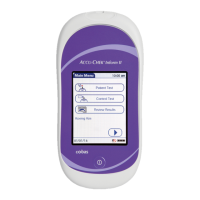9
Overview of the code key reader
Test strip vials include a code key.
This code key is read by the code
key reader and the data is sent
to the meter.
In some locations code key
calibration may be done by
the point of care team. If so you
will not use the code key reader.
The code key reader has the
following elements:
10. Code key slot
11. LED for displaying status
12. Infrared window for transmitting
the code fi le to the meter
Calibration
The Accu-Chek
®
Inform II must be calibrated for each new batch of strips.
In each pack of Accu-Chek
®
Performa test strips you will fi nd:
• A vial of Performa test strips
• A Code Key
• A package insert
It is important to note two things that appear of the label of the vial:
• Expiry Date • Lot number
Provided the strips are kept in their original vial and the cap is always
properly closed after use, the strips will be usable up to the date specifi ed.
It is important that the strips are stored correctly as heat, light and
moisture can affect them. Avoid extremes of temperatures such as
refrigerators and proximity to radiators or direct sunlight.
Roche test strips are batch matched. There may be batch variations,
so to ensure the accuracy of the system a code number which is
printed on the test strip vial and a code key are supplied with each
pack of strips.
The meter must be calibrated
• Whenever a new pack of strips is used, and coding is done using the
code key reader in your location.
• If the code number you want to use is not stored in the instrument
memory. In some locations code key calibration may be done by the
Point of Care team. If this is the case contact them for assistance in
this situation.
• If you use the Accu-Chek
®
Inform II while incorrectly
calibrated, inaccurate blood glucose readings could result.
10
11
12

